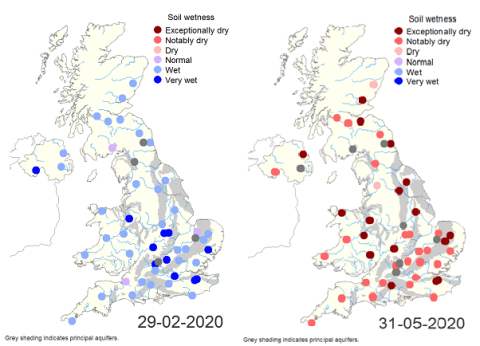Exceptionally low rainfall, soil moisture and river flows in May mean the UK may be on course for a significant drought this summer, just weeks after some record high flows and widespread flooding, according to experts at the UK Centre for Ecology & Hydrology (UKCEH).
While there has been some heavy rainfall in early June, and more is expected over the next few days, scientists warn a sustained period of wet weather will be needed to reverse the very dry conditions in some parts of the UK – particularly as high temperatures are forecast for the summer.
Analysis of current and historical data by UKCEH has shown that the exceptionally dry spring (March to May) has sent river flow and soil moisture levels plummeting over the last two months. In some cases this has been to record low levels for the time of year, including some catchments that saw flooding in February such as the Severn and Wye. Similarly, despite the wet winter, reservoir stocks fell substantially during May and by the end of the month were as much as 15-20 per cent lower than expected for the time of year.
This means the UK is entering summer with May river flows comparable to some major past drought episodes – lower than in major events like 1984 and 1976, for example, in some western rivers.
This interpretation comes from UKCEH’s expert analysis of river flow data, compiled and held by the research centre, as well as its near-real time soil moisture monitoring system, and the forward look from hydrological models and assessments carried out at UKCEH. Results of these are reported in the monthly COSMOS-UK soil moisture report, Hydrological Summary, and Hydrological Outlook published this week, and near real-time data updates can be seen via the UK Water Resources Portal.

Measurements from the COSMOS-UK network show the stark contrast in soil moisture across the country between the end of February and end of May
Katie Muchan, a Hydrologist at UKCEH, says: “This situation, with exceptionally dry soils and low river flows is concerning, and all the more remarkable given that just over three months ago there was significant flooding in many areas of the UK as a result of the wettest February on record.
“The impacts of this are clearly visible with grass in our gardens turning brown, but while our lawns will recover, the impacts for agriculture are potentially serious. There is now an increasing risk of reduced crop yields and potential water use restrictions if the lack of rainfall continues, and the forecasted high temperatures materialise.”
There is now an increasing risk of reduced crop yields and potential water use restrictions - Katie Muchan
UKCEH analysis suggests the outlook for the next month, and the next three months, is for below normal river flows to persist, particularly in northern and western parts of the UK. In contrast, the water situation in the south and east of England is healthier; groundwater levels are mostly above normal following the lasting influence of the wet winter and are likely to continue to be in the normal range.
Prof Alan Jenkins, Science Director at UKCEH, says: “At UKCEH we will continue to monitor the situation, using our measuring, observing and modelling expertise to provide the ongoing and detailed hydrological assessments and forecasts for the UK.”
For more detailed hydrological analysis read the National Hydrological Monitoring Programme’s blog, also now published on the UKCEH website.
Top facts for dry conditions in May 2020
- The UK received less than 50% of the average rainfall for May 2020
- For England and Wales, it was the driest May since records began (in 1910) with just 17% of the average rainfall, with some regions below 10% (Thames – 7%, Wessex 9%)
- By the end of May, UK soils were notably or exceptionally dry - the driest on record (from 1961) and already at similar soil moisture levels to those observed in late July 2018
- Rivers flows across the UK have been steadily dropping since mid-March, with some recording their lowest flows for the time of year since records began, 50 years ago, including the Taw in England and Tywi, Teifi, and Dee in Wales.
- Reservoir stocks fell substantially during May and are substantially below average in some reservoirs in northern and western Britain.
